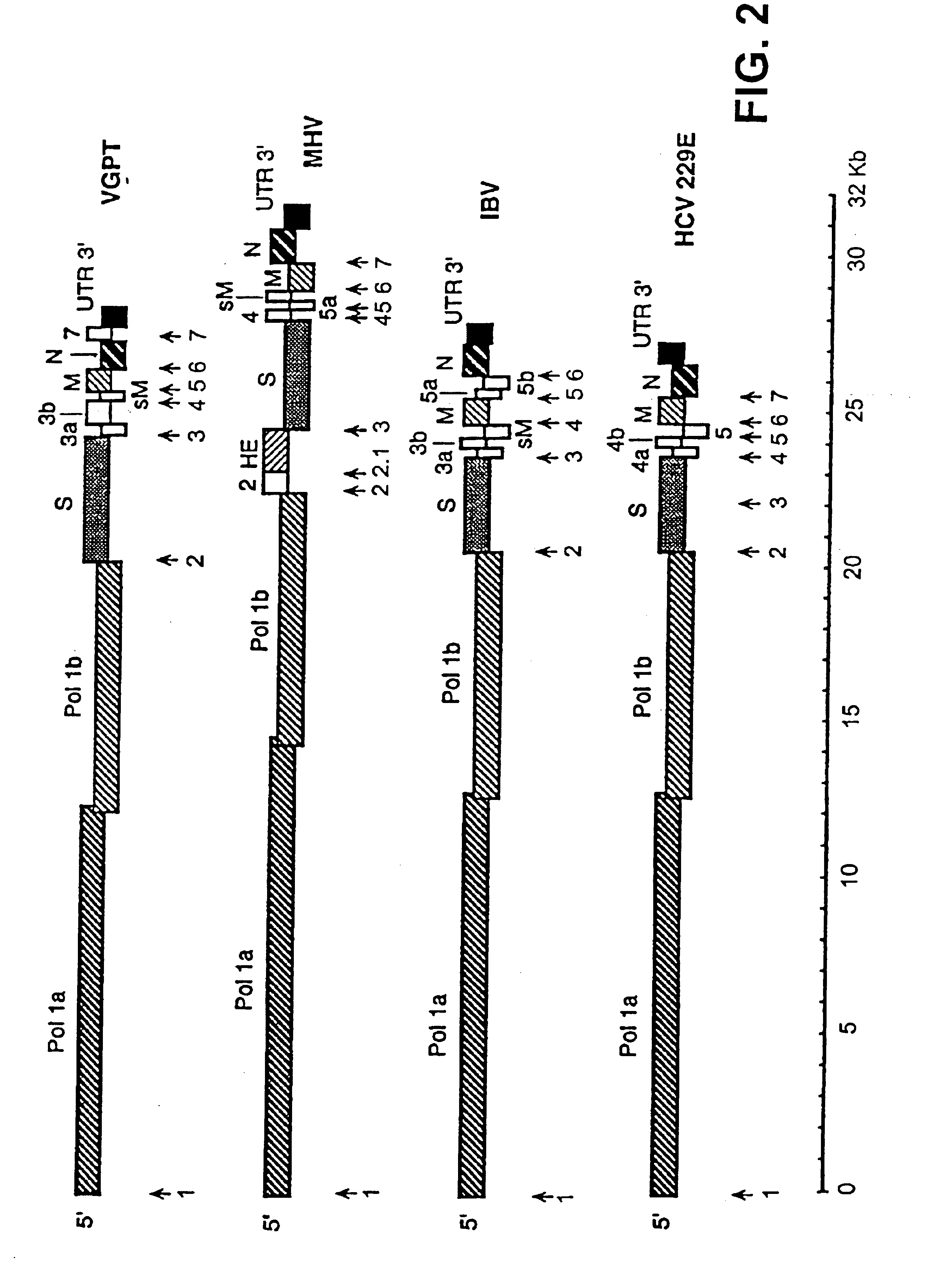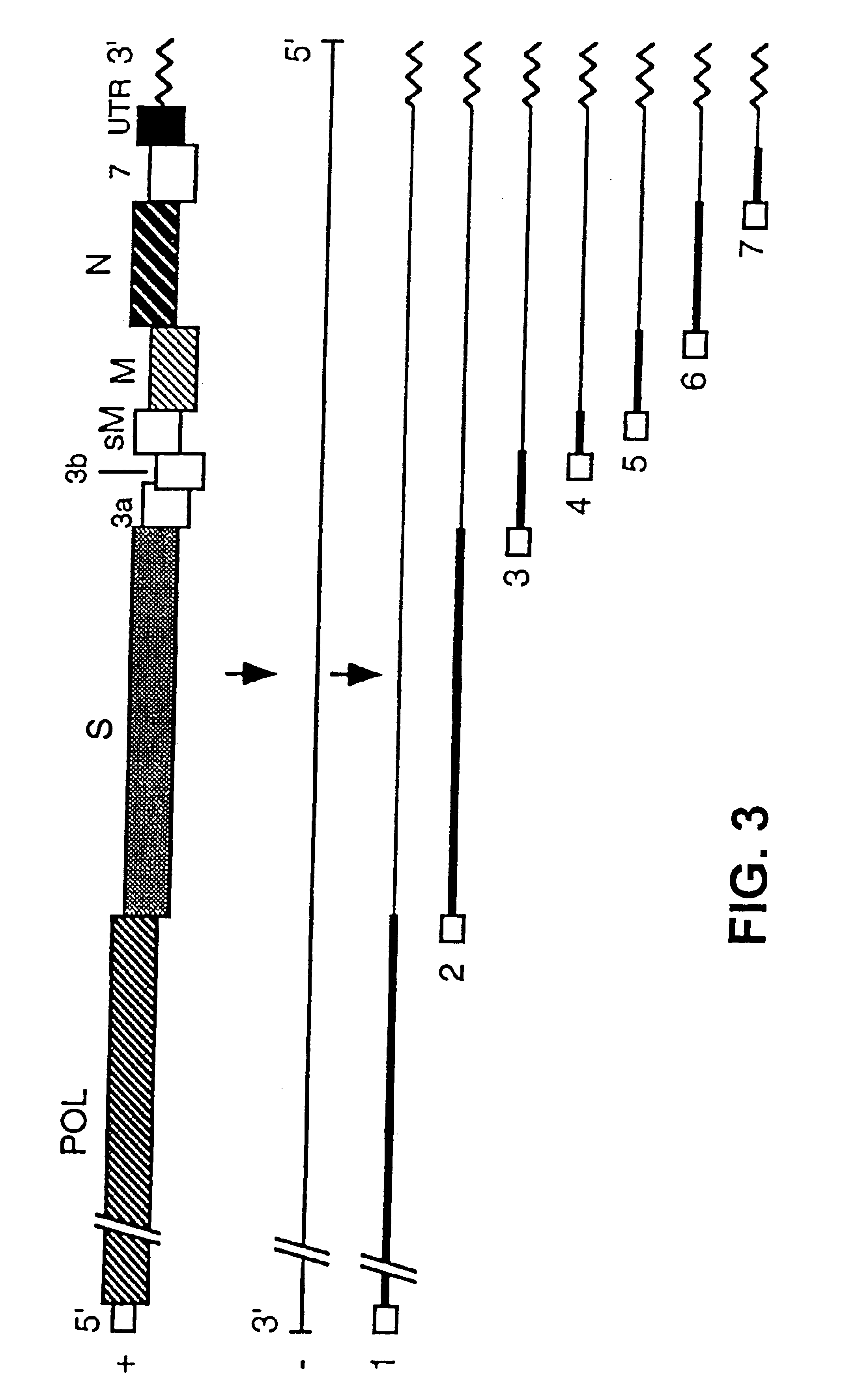Vectors based on recombinant defective viral genomes, and their use in the formulation of vaccines
a technology of defective viral genomes and vaccines, applied in the direction of viral antigen ingredients, peptide sources, antibody ingredients, etc., can solve the problems of inability to use insect cells, lack of reliable, and a number of drawbacks
- Summary
- Abstract
- Description
- Claims
- Application Information
AI Technical Summary
Problems solved by technology
Method used
Image
Examples
example 1
Generation of Defective Particles Derived from TGEV
1.1 Undiluted Serial Passages of TGEV Strains at High Multiplicity of Infection (m.o.i.)
[0076]In order to promote the generation of defective particles, or the imposition of those already existing in small proportion in the viral population, serial passages of different undiluted TGEV isolates were made in different cell systems. Because the frequency with which DI particles are generated can vary much in different virus-cell systems, the passages were done with different TGEV isolates (THER-1 and PUR46-mar 1CC12) in ST (swine tests, swine testicle epithelial cells) cell lines.
[0077]Strain THER-1 (transmissible gastroenteritis Helper Enteric and Respiratory coronavirus, strain 1) is a mutant attenuated by 20 passages in ST cell cultures derived from the PUR46-MAD strain [Sanchez et al., Virology 174, 410-417 (1990)]. Strain PUR46-mar 1CC12 is also described by Sanchez et al (supra).
[0078]Each TGEV strain was passaged undiluted 35 ti...
example 2
Generation of Expression Vectors
[0122]The cDNA coding for RNA DI-C has been cloned in a Bluescript II plasmid, under the control of the phage T7 promoter. This cDNA includes polyA sequences, a hepatitis delta virus (HDV) ribozyme, and phage T7 termination signals. One of these plasmids, whose construction appears in FIG. 17, has been denominated pDIC-1. These plasmids can be manipulated to clone in them heterologous genes under the control of the gene S promoter present in the defective genome, or another TGEV promoter, or a variant of them with increased efficiency.
[0123]The cloning of these heterologous genes was done after ORF1b, following the S gene initiation codon (AUG), and in reading phase with this gene.
[0124]From these cDNAs, RNAs were expressed using the phage T7 polymerase, with which ST cells that had been infected previously with the attenuated helper virus THER-1 were transformed, enabling to recover virions, containing the helper virus genome, and other virions, cont...
example 3
Induction of Neutralizing Antibodies
3.1 Induction of Protection Against Porcine Epidemic Diarrhea Coronavirus (PEDV)
[0126]Pigs were immunized using a recombinant system consisting of helper virus (THER-1), and the pDIC-1 plasmid in which the PEDV glycoprotein S gene had been cloned.
[0127]The immunizations were done by administering 109 pfu per piglet, via oral route.
[0128]Presence of neutralizing antibodies was assayed in the sera of animals vaccinated at 15, 30, 45 and 60 days post immunization; and presence of antibodies specific to PEDV was determined using a radio immuno-assay (RIA) (Maniatis et al., supra).
[0129]With the sera collected on the 45th day post immunization, total protection was provided against infection by PEDV (strain SEG86-1) in 10-day-old piglets, when these sera had been pre-incubated with the virulent virus before oral administration.
3.2 Induction of Protection Against Canine Coronavirus
[0130]Dogs were immunized using a recombinant system consisting of helper...
PUM
| Property | Measurement | Unit |
|---|---|---|
| density | aaaaa | aaaaa |
| density | aaaaa | aaaaa |
| polarity | aaaaa | aaaaa |
Abstract
Description
Claims
Application Information
 Login to View More
Login to View More - R&D
- Intellectual Property
- Life Sciences
- Materials
- Tech Scout
- Unparalleled Data Quality
- Higher Quality Content
- 60% Fewer Hallucinations
Browse by: Latest US Patents, China's latest patents, Technical Efficacy Thesaurus, Application Domain, Technology Topic, Popular Technical Reports.
© 2025 PatSnap. All rights reserved.Legal|Privacy policy|Modern Slavery Act Transparency Statement|Sitemap|About US| Contact US: help@patsnap.com



